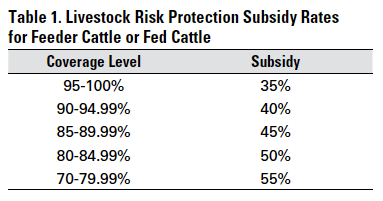Strategic Collaborations for Strength: Bagley Risk Management
Strategic Collaborations for Strength: Bagley Risk Management
Blog Article
Recognizing Livestock Danger Security (LRP) Insurance Coverage: A Comprehensive Guide
Browsing the realm of animals threat security (LRP) insurance can be an intricate endeavor for lots of in the agricultural market. This sort of insurance coverage offers a safeguard against market changes and unexpected scenarios that could influence animals manufacturers. By recognizing the intricacies of LRP insurance coverage, manufacturers can make enlightened decisions that may safeguard their operations from monetary dangers. From how LRP insurance operates to the various coverage choices available, there is much to discover in this detailed overview that might potentially shape the means animals manufacturers approach risk administration in their businesses.

Just How LRP Insurance Policy Works
Sometimes, comprehending the technicians of Animals Threat Defense (LRP) insurance can be intricate, however breaking down exactly how it works can supply quality for farmers and herdsmans. LRP insurance policy is a threat management tool developed to safeguard animals producers against unexpected rate declines. It's vital to keep in mind that LRP insurance coverage is not a revenue assurance; rather, it focuses only on rate threat security.
Eligibility and Coverage Options

When it concerns protection alternatives, LRP insurance policy provides manufacturers the adaptability to choose the protection degree, insurance coverage period, and endorsements that finest fit their threat management needs. Protection levels generally range from 70% to 100% of the anticipated finishing worth of the insured animals. Manufacturers can also select protection periods that line up with their manufacturing cycle, whether they are guaranteeing feeder livestock, fed cattle, swine, or lamb. Endorsements such as cost danger security can further personalize protection to safeguard against negative market changes. By comprehending the qualification standards and insurance coverage alternatives readily available, animals manufacturers can make educated choices to take care of danger properly.
Pros and Disadvantages of LRP Insurance
When reviewing Livestock Threat Security (LRP) insurance, it is essential for animals producers to weigh the negative aspects and advantages intrinsic in this danger administration device.

Among the key benefits of LRP insurance coverage is its capacity to offer security against a decrease in animals rates. This can aid protect producers from financial losses arising from market fluctuations. Furthermore, LRP insurance uses a degree of flexibility, enabling manufacturers to tailor insurance coverage levels and policy durations to fit their details needs. By securing in an ensured price for their livestock, producers can better handle threat and prepare for the future.
Nevertheless, there are additionally some downsides to take into consideration. One constraint of LRP insurance policy is that it does not protect against all sorts of risks, such as illness episodes or all-natural calamities. Costs can often be expensive, especially for manufacturers with huge livestock herds. It is critical for manufacturers to very carefully examine their individual risk exposure and economic circumstance to identify if LRP insurance coverage is the best risk monitoring tool for their operation.
Understanding LRP Insurance Premiums

Tips for Taking Full Advantage Of LRP Advantages
Making best use of the benefits of Livestock Danger Security (LRP) insurance policy calls for strategic preparation and proactive danger administration - Bagley Risk Management. To make the many of your LRP insurance coverage, consider the following suggestions:
On A Regular Basis Analyze Market Conditions: Stay educated regarding market patterns and cost changes in the animals industry. By keeping an eye on these aspects, you can make informed choices regarding when to buy LRP insurance coverage to secure versus prospective losses.
Set Realistic Insurance Coverage Degrees: When picking protection levels, consider your production costs, market price of animals, and prospective dangers - Bagley Risk Management. Setting reasonable coverage levels guarantees that you are adequately shielded without paying too much for unnecessary insurance coverage
Diversify Your Coverage: Rather than counting exclusively on LRP insurance policy, take into consideration expanding your danger administration approaches. Integrating LRP with various other threat monitoring devices such as futures contracts or choices can offer comprehensive insurance coverage against market unpredictabilities.
Evaluation and Adjust Insurance Coverage Frequently: As market conditions transform, occasionally examine your LRP coverage to guarantee it lines up with your current risk direct exposure. Changing coverage levels and timing of acquisitions can assist optimize your danger defense method. By following these pointers, you can make the most of the advantages of LRP insurance policy and safeguard your animals procedure against unanticipated risks.
Verdict
Finally, animals risk protection (LRP) insurance policy is a valuable device for farmers to take care of the financial risks related to their livestock operations. By understanding exactly how LRP functions, eligibility and protection alternatives, along with the pros and cons of this insurance policy, farmers can make informed decisions to protect their livelihoods. By thoroughly considering LRP costs and implementing methods to optimize advantages, farmers can minimize potential losses and guarantee the sustainability of their procedures.
Animals manufacturers interested in obtaining Livestock Danger Defense (LRP) insurance policy can explore an array of eligibility requirements read this post here and insurance coverage alternatives customized to their particular livestock operations.When it comes to coverage choices, LRP insurance coverage uses manufacturers the versatility to choose the insurance coverage degree, protection duration, and endorsements that best suit their danger monitoring demands.To understand the details of Animals Threat Defense (LRP) insurance policy totally, understanding the factors affecting LRP insurance costs is crucial. LRP insurance policy costs are established by numerous components, consisting of the insurance coverage degree selected, the anticipated cost of animals at the end of the protection period, the type of livestock being guaranteed, and the size of the coverage duration.Review and Change Protection Regularly: As market problems change, periodically review your LRP insurance coverage to ensure it straightens with your existing danger direct exposure.
Report this page